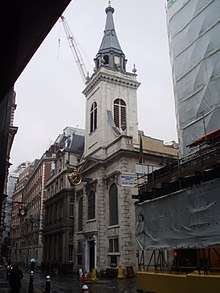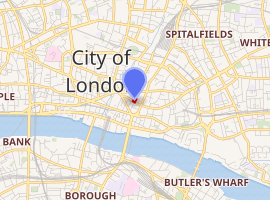St Edmund, King and Martyr
St Edmund, King and Martyr, is an Anglican church in Lombard Street, in the City of London, dedicated to St Edmund the Martyr.[1]
| St Edmund King and Martyr | |
|---|---|
| Saint Edmund the King and Martyr | |
 Photo of the church today | |

| |
| Location | Lombard Street, London EC3V 9EA |
| Country | England |
| Denomination | Church of England |
| Previous denomination | Roman Catholic |
| Website | https://www.lombardchurches.org/ |
| Architecture | |
| Functional status | Consecrated but no regular worship |
| Heritage designation | Grade I |
| Architect(s) | Sir Christopher Wren |
| Style | Baroque |
| Administration | |
| Deanery | City of London |
| Archdeaconry | London |
| Episcopal area | Two Cities |
| Diocese | London |
- For the 9th-century King of East Anglia, Martyr and Saint, see Edmund the Martyr.
Since 2001 it houses the London Centre for Spirituality, now (2017) renamed the London Centre for Spiritual Direction[2], but is still a consecrated church.
In 2015, church become an office of Ric Thorpe, Bishop of Islington and organisation he leads, Centre for Church Multiplication[3]
Since 2019, Imprint Church[4] organises regular worship inside of the building. [5][6][7]
The church lies in the ward of Langbourn, and has a ward noticeboard outside.
History
In 1292, the church is first recorded as 'Saint Edmund towards Garcherche',[8] and it reappears in 1348 as 'Saint Edmund in Lombardestrete'. John Stow, in his Survey of London 1598, revised during 1603, refers to it also as St Edmund Grass Church.[9]
The medieval church was destroyed in the Great Fire of 1666.[10] After the fire the parish was united with that of St Nicholas Acons, which was also destroyed and not rebuilt.[11] The present church was constructed to the designs of Sir Christopher Wren in 1670–1679,[12] with a tower ornamented at the angles by flaming urns in allusion to the Great Fire.[13] George Godwin described the tower as "more Chinese than Italian",[14] while James Peller Malcolm called it "rather handsome, but of that species of architecture which is difficult to describe so as to be understood".[11] The orientation of the church is unusual, with the altar towards the north, instead of east.[15]
The essayist Joseph Addison was married here in 1716.[15]
In September 1868 a riot occurred outside the church, as a consequence of one of a series of Friday morning sermons given by the Rev. J. L. Lyne – known as "Father Ignatius" – in which he had spoken disparagingly of the traders of Lombard Street.[16]
The church was restored in 1864 and 1880. It was damaged by bombing in 1917.[17]
The church was designated a Grade I listed building on 4 January 1950.[18]
Previous rectors
Rectors of the church have included Thomas Lyndford, chaplain in ordinary to George I, and Jeremiah Milles, president of the Society of Antiquaries.[11] After the Great War, Studdert Kennedy was given charge of St Edmund, King and Martyr. He moved to work for the Industrial Christian Fellowship, for whom he went on speaking tours of Britain. It was on one of these tours that he was taken ill. He died in Liverpool in 1929, exhausted at the age of 45, and poor people flocked to his funeral in Worcester, for the Dean of Westminster refused burial at the Abbey because, he said, Studdert Kennedy was a "socialist".[19]
Present day
The church and parish now forms part of the combined parish of St Edmund the King and Martyr, and St Mary Woolnoth Lombard Street with St Nicholas Acons, All Hallows Lombard Street, St Benet Gracechurch, St Leonard Eastcheap, St Dionis Backchurch and St Mary Woolchurch Haw – usually shortened to "St Edmund & St Mary Woolnoth" (the only two aforementioned churches to have survived). It is part of the Church of England's Diocese of London.[20] and accommodates the office of the Bishop of Islington.[21]
Gallery
 Historic engraving
Historic engraving- Now a Centre for Spirituality
- Interior
References
- "The London Encyclopaedia" Hibbert,C;Weinreb,D;Keay,J: London, Pan Macmillan, 1983 (rev 1993,2008) ISBN 978-1-4050-4924-5
- Direction, London Centre for Spiritual. "London Centre for Spiritual Direction". London Centre for Spiritual Direction. Retrieved 24 May 2020.
- "Centre for Church Multiplication". CCX. Retrieved 24 May 2020.
- "Home". We are IMPRINT. Retrieved 24 May 2020.
- ADMINOctober 11, C. C. X.; October 27th, 2019; 2019 (11 October 2019). "Launch of IMPRINT Church London". CCX. Retrieved 24 May 2020.CS1 maint: numeric names: authors list (link)
- "24 year old plants his second church". Diocese of London. 1 October 2019. Retrieved 24 May 2020.
- "IMPRINT Church London". www.achurchnearyou.com. Retrieved 24 May 2020.
- London Guide
- "In and around Lombard Street". City of London Essays. Archived from the original on 3 March 2016. Retrieved 11 April 2009.
- "The City Churches" Tabor, M. p74:London; The Swarthmore Press Ltd; 1917
- Malcolm, James Peller (1803). Londinium Redivivium, or, an Ancient History and Modern Description of London. 3. London. pp. 467–70.
- "The Old Churches of London" Cobb,G: London, Batsford, 1942
- "London:the City Churches" Pevsner,N/Bradley,S New Haven, Yale, 1998 ISBN 0-300-09655-0
- Godwin, George; John Britton (1839). The Churches of London: A History and Description of the Ecclesiastical Edifices of the Metropolis. London: C. Tilt. p. 345.
- "The Churches of the City of London" Herbert Reynolds 2008 ISBN 1-4097-1376-8
- The Times (London, England), Saturday, 19 September 1868; pg. 9; Issue 26234
- "A biographical dictionary of British architects, 1600–1840" Yale 2008 ISBN 0-300-12508-9
- Historic England. "Details from listed building database (1064631)". National Heritage List for England. Retrieved 23 January 2009.
- Geoffrey Studdert Kennedy
- Diocese of London St Edmund & St Mary Woolnoth
- https://www.london.anglican.org/directory/ric-thorpe/
External links
| Wikimedia Commons has media related to St Edmund the King and Martyr. |